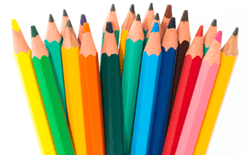Caring for Others ✝ Achieving Excellence






Design Technology
“Enjoy failure and learn from it. You can never learn from success.” James Dyson
Intent: At St Johns our vision statement aspires for all to have a ‘wonder and curiosity for God’s creation’: we want our children to use creativity and their curiosity to design and make products that solve problems in a range of contexts. We want our children to consider their own and others needs in these designs building on and acquiring appropriate subject knowledge, skills and understanding. Learning how to take risks, becoming resourceful, innovative, enterprising and capable citizens. Through the evaluation of past and present design and technology, they develop a critical understanding of its impact on daily life and the wider world.
Implementation: At St John’s we have adopted the ‘Projects on a Page’ scheme of work by the D&T Association. Based on the universal principles of effective teaching and learning in D&T (design, make, evaluate) projects on a Page was designed to implement the National Curriculum for D&T.
Key knowledge, skills and vocabulary have been mapped across the school to ensure clear progression through the year groups and opportunities to revisit to build on prior learning. Our curriculum covers the following strands: Mechanisms, Food/Cooking, Textiles, Mechanical Systems, Structures, Electrical Systems.
Our DT curriculum is delivered in the following sequence:
- The Hook - A question, hypothesis or challenge where links to the wider curriculum can be made.
- The Investigate, Disassemble and Evaluate Activities (IDEAs) - investigate, dissemble and evaluate existing products developing technical knowledge.
- The Focused Practical Tasks (FTPs) - specific tasks which will help inform their design and draw on skills and knowledge
- The Design, Make and Evaluate Assignment (DMEA) – communicate their ideas in a variety of ways – talking, drawing, making simple mock-ups, annotated sketches, exploding diagrams as well as using CAD technology.
- Children will be encouraged to evaluate their ideas and products as the project progresses, making adaptations as needed. They will also evaluate their finished product and those of others against the brief, suggesting possible improvements.
EYFS: Design Technology in EYFS encourages creativity and problem-solving. Children explore materials like paper, wood, and fabric to design and make simple objects, such as models or collages. They learn to use tools safely, like scissors or glue, fostering fine motor skills. Activities link to real-world contexts, like building a house for the 3 Little Pigs or a boat for a pirate, sparking curiosity.
Adults and peers support trial and error, helping children adapt their ideas. This aligns with the EYFS ‘Expressive Arts and Design’ area, promoting imagination and practical skills. By experimenting and reflecting, children develop confidence in creating, laying foundations for later design technology learning.
Impact: Children will complete Design Project books throughout the unit which demonstrate that children will have had clear enjoyment and valued learning experiences in Design and Technology. Carefully planned tasks and opportunities for retrieval practice provide opportunities to assess what has been taught and remembered by children in this unit and from previous units. Additionally, children will develop the creative, technical and practical expertise needed to confidently perform and participate in everyday tasks in an increasingly technological world.
Click the link below to down the whole school curriculum overview for Design Technology.
Click below to download the year group learning journeys for Design Technology.
Year 1 Design Technology Learning Journey
Year 2 Design Technology Learning Journey
Year 3 Design Technology Learning Journey
Year 4 Design Technology Learning Journey
Year 5 Design Technology Learning Journey
Year 6 Design Technology Learning Journey
Examples of our Design Technology Projects.
Year 1 Design and make a bug hotel (Freestanding structures)
Year 3 Design and make a bag (Textiles)
Year 6 Design and make a pulley system (Mechanisms - pulleys)






